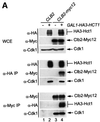Yeast Hct1 recognizes the mitotic cyclin Clb2 and other substrates of the ubiquitin ligase APC
- PMID: 11566880
- PMCID: PMC125620
- DOI: 10.1093/emboj/20.18.5165
Yeast Hct1 recognizes the mitotic cyclin Clb2 and other substrates of the ubiquitin ligase APC
Abstract
Ubiquitin-mediated proteolysis has emerged as a key mechanism of regulation in eukaryotic cells. During cell division, a multi-subunit ubiquitin ligase termed the anaphase promoting complex (APC) targets critical regulatory proteins such as securin and mitotic cyclins, and thereby triggers chromosome separation and exit from mitosis. Previous studies in the yeast Saccharomyces cerevisiae identified the conserved WD40 proteins Cdc20 and Hct1 (Cdh1) as substrate-specific activators of the APC, but their precise mechanism of action has remained unclear. This study provides evidence that Hct1 functions as a substrate receptor that recognizes target proteins and recruits them to the APC for ubiquitylation and subsequent proteolysis. By co-immunoprecipitation, we found that Hct1 interacted with the mitotic cyclins Clb2 and Clb3 and the polo-related kinase Cdc5, whereas Cdc20 interacted with the securin Pds1. Failure to interact with Hct1 resulted in stabilization of Clb2. Analysis of Hct1 derivatives identified the C-box, a motif required for APC association of Hct1 and conserved among Cdc20-related proteins. We propose that proteins of the Cdc20 family are substrate recognition subunits of the ubiquitin ligase APC.
Figures
















Similar articles
-
The regulation of Cdc20 proteolysis reveals a role for APC components Cdc23 and Cdc27 during S phase and early mitosis.Curr Biol. 1998 Jun 18;8(13):750-60. doi: 10.1016/s0960-9822(98)70298-2. Curr Biol. 1998. PMID: 9651679
-
Cdc20 is essential for the cyclosome-mediated proteolysis of both Pds1 and Clb2 during M phase in budding yeast.Curr Biol. 1998 Feb 12;8(4):231-4. doi: 10.1016/s0960-9822(98)70088-0. Curr Biol. 1998. PMID: 9501986
-
CDC20 and CDH1: a family of substrate-specific activators of APC-dependent proteolysis.Science. 1997 Oct 17;278(5337):460-3. doi: 10.1126/science.278.5337.460. Science. 1997. PMID: 9334304
-
Cyclin destruction in mitosis: a crucial task of Cdc20.FEBS Lett. 2002 Dec 4;532(1-2):7-11. doi: 10.1016/s0014-5793(02)03657-8. FEBS Lett. 2002. PMID: 12459453 Review.
-
Cyclin A and Nek2A: APC/C-Cdc20 substrates invisible to the mitotic spindle checkpoint.Biochem Soc Trans. 2010 Feb;38(Pt 1):72-7. doi: 10.1042/BST0380072. Biochem Soc Trans. 2010. PMID: 20074038 Review.
Cited by
-
The anaphase promoting complex contributes to the degradation of the S. cerevisiae telomerase recruitment subunit Est1p.PLoS One. 2013;8(1):e55055. doi: 10.1371/journal.pone.0055055. Epub 2013 Jan 25. PLoS One. 2013. PMID: 23372810 Free PMC article.
-
Xkid is degraded in a D-box, KEN-box, and A-box-independent pathway.Mol Cell Biol. 2003 Jun;23(12):4126-38. doi: 10.1128/MCB.23.12.4126-4138.2003. Mol Cell Biol. 2003. PMID: 12773557 Free PMC article.
-
The zinc-binding region (ZBR) fragment of Emi2 can inhibit APC/C by targeting its association with the coactivator Cdc20 and UBE2C-mediated ubiquitylation.FEBS Open Bio. 2014 Jul 5;4:689-703. doi: 10.1016/j.fob.2014.06.010. eCollection 2014. FEBS Open Bio. 2014. PMID: 25161877 Free PMC article.
-
The PP2AB56 phosphatase promotes the association of Cdc20 with APC/C in mitosis.J Cell Sci. 2017 May 15;130(10):1760-1771. doi: 10.1242/jcs.201608. Epub 2017 Apr 12. J Cell Sci. 2017. PMID: 28404789 Free PMC article.
-
Analysis of activator-binding sites on the APC/C supports a cooperative substrate-binding mechanism.Mol Cell. 2009 Apr 10;34(1):68-80. doi: 10.1016/j.molcel.2009.02.027. Mol Cell. 2009. PMID: 19362536 Free PMC article.
References
-
- Adams A., Gottschling,D.E., Kaiser,C.A. and Stearns,T. (1997) Methods in Yeast Genetics. Cold Spring Harbor Laboratory Press, Cold Spring Harbor, NY.
-
- Amon A. (1999) The spindle checkpoint. Curr. Opin. Genet. Dev., 9, 69–75. - PubMed
-
- Amon A., Irniger,S. and Nasmyth,K. (1994) Closing the cell cycle circle in yeast: G2 cyclin proteolysis initiated at mitosis persists until the activation of G1 cyclins in the next cycle. Cell, 77, 1037–1050. - PubMed
-
- Bäumer M., Braus,G.H. and Irniger,S. (2000) Two different modes of cyclin Clb2 proteolysis during mitosis in Saccharomyces cerevisiae. FEBS Lett., 468, 142–148. - PubMed
Publication types
MeSH terms
Substances
LinkOut - more resources
Full Text Sources
Other Literature Sources
Molecular Biology Databases
Miscellaneous

